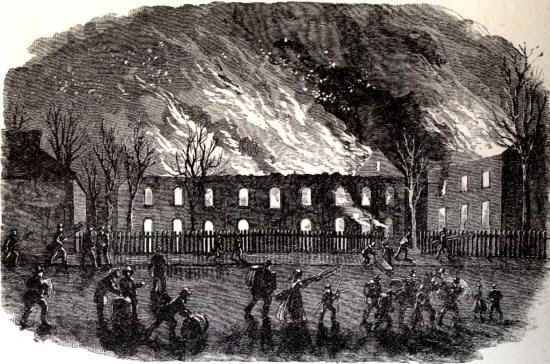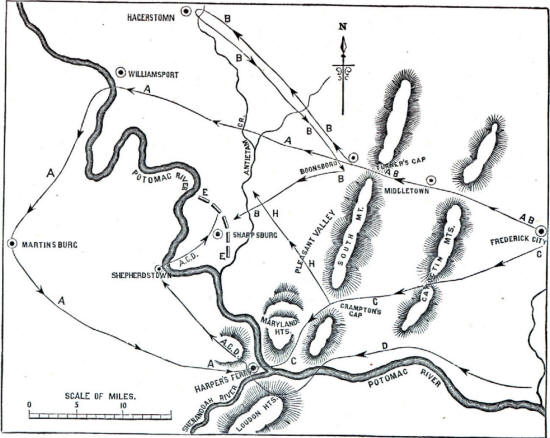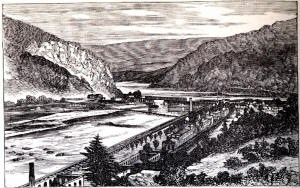|
80,000 to
90,000 stand of arms were generally stored. When the secession movement began, at the close of 1860, measures were taken for the security of this post. A small body of United States dragoons, under the command of Lieut. Roger Jones, was sent there as a precautionary measure. After the attack on
Fort Sumter, rumors reached Harper's Ferry that the government property there would he speedily seized by the Virginians. The rumors were true. On the morning of April 18 the military commanders at
Winchester and Charlestown received orders from Richmond to seize the armory and arsenal that night. They were further ordered to march into Maryland, where, it was expected, they would be joined by the minute-men of that State in an immediate attack on Washington. About 3,000 men were ordered out, but only about 250 were at the designated rendezvous, 4 miles from the Ferry, at the appointed hour—eight o'clock in the evening—but others were on the march. The cavalry, only about twenty strong, were commanded by Captain Ashby. When the detachment was within a mile of the Ferry, there was suddenly a flash and explosion in that direction. This was quickly repeated, and the mountain heights were soon illuminated by flames. Ashby dashed towards the town, and soon returned with a report that the armory and arsenal were on fire, and that the National troops had crossed the Potomac, and taken the mountain road in the direction of Carlisle Barracks, in Pennsylvania. Lieutenant Jones had been secretly warned, twenty-four hours before, of the plan for seizing the post that night. There were indications all around him of impending troubles.

BURNING OF THE ARSENAL, HARPER'S FERRY Trains of powder were so prepared that, at a moment's warning, the powder in the magazine might be exploded, and the government buildings be set on fire. Word came to Jones, at near ten o'clock at night, that 2,000 Virginians were within twenty minutes' march of him. The trains were fired, and the whole public property that was combustible was soon in ashes. Then Jones and his little garrison fled across the Potomac, and reached
Hagerstown in the morning, and thence pushed on to Chambersburg and Carlisle Barracks. Jones was highly commended by his government. The Confederate forces immediately took possession of ruined Harper's Ferry as a strategic point. Within a month fully 8,000 Virginians, Kentuckians, Alabamians, and South Carolinians were there, menacing Washington. General
Joseph E. Johnston was then charged with the duty of holding Harper's Ferry.
General McClellan was throwing Ohio troops into western Virginia, and
Gen. Robert Patterson, in command of the Department of Pennsylvania, was rapidly gathering a force at Chambersburg, Pa., under Gen. W. H. Keim. A part of the Confederates at the Ferry were on Maryland Heights, on the left bank of the Potomac, and against these Patterson marched from Chambersburg with about 15,000 men in June, 1861. Just at this moment commenced Wallace's dash on
Romney, which frightened
Johnston, and he abandoned Harper's Ferry, and moved up the valley to Winchester. Before leaving he destroyed the great bridge of the Baltimore and Ohio Railway at the Ferry with fire and gunpowder. It was 1,000 feet long. Then he spiked the heavy guns that could not be taken away, and encamped a few miles up the valley. Patterson, who was at Hagerstown, Md., pushed on, and on June 16 and 17 about 9,000 of his troops crossed the Potomac by fording it at
Williamsport. These were led by Brig.-Gen. George Cadwalader, at the head of five companies of cavalry. At that moment Patterson received orders by telegraph from
General Scott, at Washington, to send to him all the regulars, horse and foot, under his (Patterson's) command, and a Rhode Island regiment. Patterson was embarrassed, and requested the general to leave the regulars with him, for he expected to hold the position and to keep open a free communication with the great West by the Baltimore and Ohio Railway. Scott refused, saying, " We are pressed here; send the troops without delay." The order was obeyed, and Patterson was left without a single piece of available artillery, with only one troop of raw cavalry, and a total force of not more than 10,000 men, mostly undisciplined, to confront
Johnston with fully 15,000 drilled troops. Patterson prudently re-crossed the Potomac, and remained on the Maryland side until the beginning of July. While
Robert E. Lee was in Maryland, in September, 1862, Harper's Ferry, where a large amount of stores had been gathered, was held by National troops, under Col. D. H. Miles. When that post was threatened,
Halleck instructed
McClellan to succor the garrison, and on the day of the struggle at Turner's Gap he ordered Miles to hold out to the last extremity. Meanwhile
Jackson, by quick movements, had crossed the Potomac at Williamsport, and at noon on Sept. 13 he was in the rear of Harper's Ferry.

MOVEMENTS AROUND HARPER'S FERRY, FROM SEPT, 10 TO 17, 1862. A, A. - Jackson's march from Frederick to Sharpsburg. D, D - Walker's march from Monocacy to Sharpsburg. B, B - Longstreet's march from Frederick to Sharpsburg. E, E - Confederate position, at Antietam. C, C -Mclaws and Anderson's march from Frederick to Sharpsburg. H, H. Franklin's march from Pleasant Valley to Antietam. Franklin followed the same route as McLaws from Frederick to Pleasant Valley; the remainder of the Union Army that of Longstreet from Frederick to Boonesboro, and thence to the Antietam. The arrows show the direction of the march. Where two or more letters come together, It indicates that the several bodies followed the same route. The Confederates were then in possession of London Heights and also of Maryland Heights, which commanded Harper's Ferry. That post was completely invested by the Confederates on the 14th. Miles was told by
McClellan to " hold on," and also informed how he might safely escape. But he appeared to pay no attention to instructions, and to make no effort at defense; and when, early on the 15th, no less than nine batteries opened upon the garrison, he displayed a white flag. Before it was seen by the Confederates, one of their shots had killed him. The post was surrendered, with all its troops, ordnance, ammunition, and stores. There were 11,583 men—half of them New-Yorkers—surrendered, and the spoils were seventy-three cannon, 13,000 small-arms. 200 wagons and a large quantity of tents and camp equipage. it was shown that Miles had disobeyed orders to take measures for the defense of the post, and he was strongly suspected of sympathy with the Confederate cause. |


